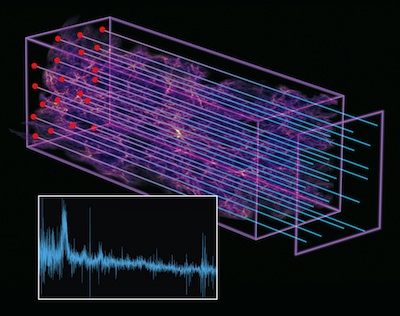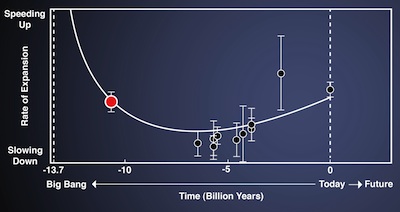
New technique brings ancient dark energy into focus
BY STEPHEN CLARK
SPACEFLIGHT NOW
Posted: 14 November 2012

Scientists are using light from distant quasars to chart the history of dark energy, and they hope to use the new technique to learn how the mysterious force came to dominate the universe.

SDSS-III was able to measure the expansion rate of the distant Universe by using quasars to probe the distribution of hydrogen along the line of sight from the each quasar (red dots in the upper left) to the Sloan Foundation 2.5-m Telescope on Earth (abstractly represented as the plane in the lower right). Credit: Zosia Rostomian, LBNL; Nic Ross, BOSS Lyman-alpha team, LBNL; Springel et al, Virgo Consortium and the Max Planck Institute for Astrophysics
Astronomers attribute the accelerating expansion of the universe to dark energy. Scientists believe about 73 percent of the universe's mass and energy is comprised of dark energy.
Some time in the ancient universe, the influence of dark energy overcame the gravitational pull of normal matter. Before this point, the universe's growth rate was decelerating.
"If we think of the universe as a roller coaster, then today we are rushing downhill, gaining speed as we go," said Nicolas Busca of the Laboratoire Astroparticule et Cosmologie of the French Centre National de la Recherche Scientifique. "Our new measurement tells us about the time when the universe was climbing the hill - still being slowed by gravity."
The Baryon Oscillation Spectroscopic Survey, or BOSS, an international collaboration of scientists, has made the first measurement of the universe's expansion rate more than 10 billion years ago - about three billion years after the Big Bang.
BOSS is the largest observing program of the third Sloan Digital Sky Survey. BOSS studies dark energy by mapping baryon acoustic oscillations, small variations in the distribution of matter left over from the early universe.
The baryon acoustic oscillations, or BAO, allow astronomers to discern the size of the universe at various points throughout its history, according to a statement by the Sloan Digital Sky Survey.
In a paper submitted to the journal Astronomy & Astrophysics, scientists in the BOSS collaboration announced they found a novel way of measuring the universe's expansion rate when it was one-fifth its current age.
"No technique for dark energy research has been able to probe this ancient era before, a time when matter was still dense enough for gravity to slow the expansion of the universe, and the influence of dark energy hadn't yet been felt," said David Schlegel, BOSS principal investigator from the U.S. Energy Department's Lawrence Berkeley National Laboratory. "In our own time, expansion is accelerating because the universe is dominated by dark energy. How dark energy effected the transition from deceleration to acceleration is one of the most challenging questions in cosmology."
The BOSS measurements show the expansion of the universe was slowing down 11 billion years ago, scientists said, due to the gravitational attraction between galaxies. As the universe grew, the matter became more dispersed, and the influence of dark energy took hold.

A new measurement from SDSS-III BOSS reaches twice as far into the past as previous direct measurements of the expansion rate (illustrated by the red dot on the left-hand side). The expansion rate of the Universe was slowing down 10 billion years ago, and started to speed up due to the influence of dark energy 6 billion years ago. Credit: Zosia Rostomian, LBNL; Nic Ross, BOSS Lyman-alpha team, LBNL
"More than eighty years after Edwin Hubble and Georges Lemaitre first measured the expansion rate of the nearby universe, the [Sloan survey] has made the same measurement of the expansion rate of the universe 11 billion years ago," astronomers said in a statement.
Instead of using light from ancient galaxies - they are too faint - astronomers measured light from quasars, the brightest objects in the universe.
Brilliant emissions from more than 48,000 quasars raced through more than 10 billion light-years of space before reaching a telescope at the Apache Point Observatory in New Mexico.
Astronomers used instrumentation to measure the spectra of the quasar light, which must travel through clouds of intergalactic gas on its way to Earth. The gas's absorption of quasar light is called the Lyman-alpha forest.
"It's a cool technique, because we're essentially measuring the shadows cast by gas along a single line billions of light-years long," says Anze Slosar of Brookhaven National Laboratory. "The tricky part is combining all those one-dimensional maps into a three-dimensional map. It's like trying to see a picture that's been painted on the quills of a porcupine."
Scientists hope to collect more data on dark energy as the survey observes more than 160,000 quasars and 1.5 billion galaxies shining through the 'Lyman-alpha forest' of intergalactic gas.
"It looks like the roller coaster crested the hill just about seven billion years ago, and we're still going," Busca said.
|



